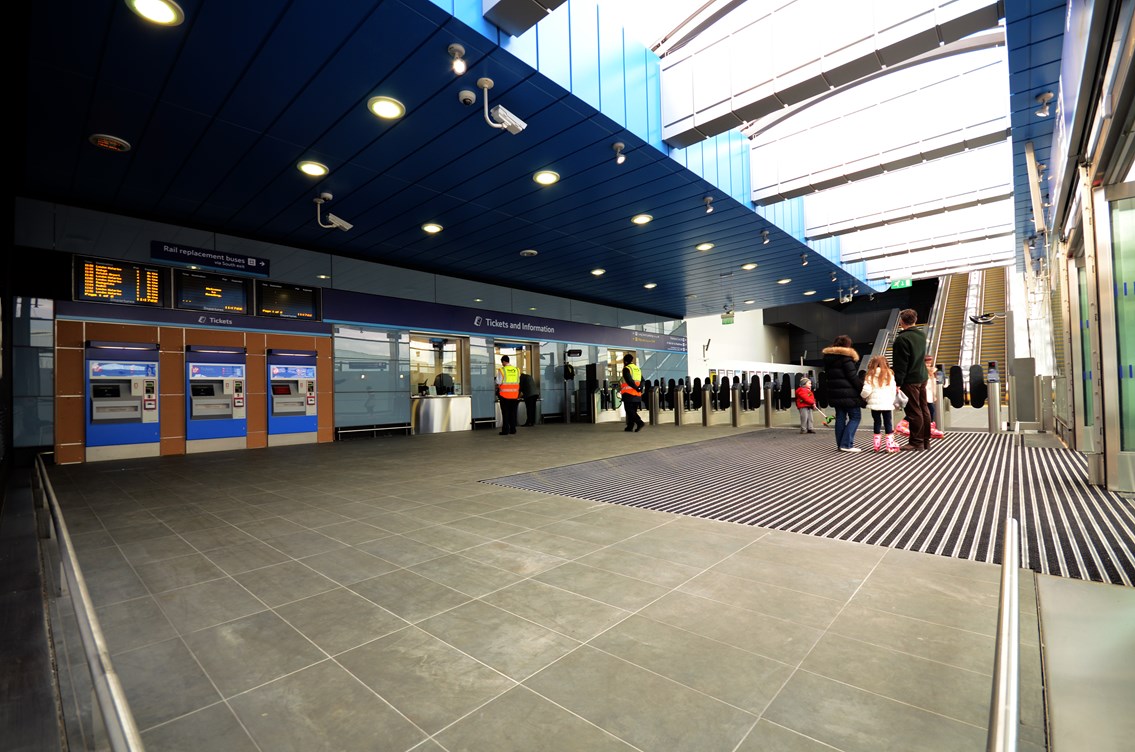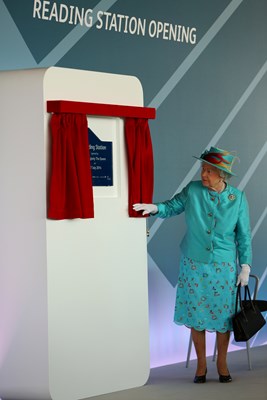Thursday 17 Jul 2014
Her Majesty The Queen opens redeveloped Reading station
- Region & Route:
- National
Reading’s redeveloped railway station was officially opened by Her Majesty The Queen today.
Used by nearly 20m passengers a year, Reading station is one of the busiest rail hubs in Britain. It has been transformed by Network Rail in the last five years as part of a £895m project to rebuild the railway around Reading which will remove one of the worst remaining bottlenecks on the network, improving reliability and increasing capacity so more trains can run in the future.
The bigger, better station – completed a year ahead of schedule and within budget – now has two entrances, 15 platforms including five new platforms, new retail facilities and a new passenger bridge three times the size of the original footbridge. All platforms have new lifts, escalators and canopies making the station more accessible, lighter and brighter and better able to accommodate the growing number of passengers, with 30m people forecast to use the station by 2030.
The Queen met key members of the engineering team behind the project and unveiled a plaque marking the official opening of the new and improved station. Her Majesty was also joined by more than 100 railway workers involved in the construction for a special group photograph to mark the occasion
Network Rail chairman, Richard Parry-Jones, said: “We are extremely honoured that Her Majesty has officially opened the new Reading station. Thousands of men and women have worked on this project over the last five years and this is a proud moment for them and for the entire rail industry.
“The scale of the new station here at Reading reflects the huge and growing demand for rail travel in Britain and it has already started to deliver a better experience for passengers.”
The official opening of Reading station is a significant milestone in the Reading Station Area Redevelopment Programme, with the overall set of enhancement works – including a new viaduct to the west of the station which will cut delays and increase capacity so more trains can run in future – set to complete in spring 2015, also a year earlier than originally planned.
Mr Parry-Jones continued: “Brunel’s railway is an engineering marvel, but Reading has been a bottleneck on the line almost since the day it was built. In a year’s time that bottleneck will be gone, paving the way for an electrified railway with new trains providing more seats and better journeys for passengers and driving economic growth across the region.”
First Great Western Managing Director, Mark Hopwood, said: "Reading station is one of the busiest on our network and many more customers than this will pass through on their way to key destinations.
"The investment Network Rail has made is welcome and I look forward to seeing the benefits that this will bring with increased punctuality and reliability, and an improved range of facilities at this important station. This is one of the first, visible outputs of large scale investment in the Great Western network, with more to come."
Cllr Tony Page, Reading Borough Council’s deputy leader and lead member for strategic environment, planning and transport, said: “This project is the culmination of a great deal of hard work over the years by Reading Borough Council who, working in collaboration with local stakeholders, can rightly claim the credit for persuading the previous government to give the go-ahead to the Reading station upgrade project.
“These works recognise the importance to the nation’s railways of delivering extra train capacity and benefits not only to train passengers but also to the growing rail freight industry. The works at Reading station are essential to the town both in terms of connecting Reading with the capital and for commuters coming to work in the borough from all around the Thames Valley. The new viaduct to the west of the station – so important to the whole project - delivers two brand new bridges over Cow Lane which, from next summer, will allow improved connections to and from west Reading and, for the first time ever, new bus services along Richfield Avenue.
“The council has also added to the station redevelopment by promoting and building the new northern interchange. The improved southern interchange is due to open in the autumn and we are grateful to the present government for their continued support and an extra contribution towards these works.”
CrossCountry’s managing director, Andy Cooper, said: “This greatly improved Reading station means our customers can now experience a bright, modern station environment and faster and more reliable journeys. Enhanced connectivity to the South Coast, the Midlands and the North of England for the almost three million CrossCountry customers that use this station each year will allow Reading to continue to grow and prosper as a key part of Britain’s national rail network.”
The Reading station area redevelopment programme is part of the government’s £7.2bn investment to upgrade and modernise the Great Western route, which includes electrification of the line from London to Bristol (including Newbury and Oxford) by 2016 and to Cardiff by 2017.
Much of the electrification work will be carried out by a specially designed engineering train – a 23-vehicle factory on wheels – which will enable Network Rail to work without closing the line to trains. As part of her visit, The Queen named the engineering train ‘Brunel’, after Isambard Kingdom Brunel, the engineer who built the Great Western main line.
Notes to editors
This is the Queen’s second visit to Reading station. In 1989, Her Majesty opened the station following a £20m refurbishment. The Reading project is on budget and on schedule for completion a year earlier than originally planned. More information can be found at www.networkrail.co.uk/aspx/6339.aspx
The viaduct
- Over the next year, the project team at Reading will continue its work to complete the new viaduct which it started in 2013. This work will help end the bottleneck at Reading providing more trains and quicker, more comfortable journeys for passengers.
- This will be achieved by allowing fast passengers services to and from places like Bristol and South Wales to fly over the lines to Newbury, Basingstoke and the south west of England
Crossrail and electrification
- The Crossrail extension to and from Reading (2018) will mean two direct trains an hour from Reading, with passengers able to travel into, and beyond, central London without the need to change at Paddington for the first time.
- The rebuilding of the railway at Reading, the extension of Crossrail and electrification of the Great Western main line will mean faster, better and more reliable connections to and from Reading, more seats and a boost to the economy in the Thames Valley.
‘Brunel’ – a factory on rails
- A factory on rails, ‘Brunel’ (formerly known as the High Output Plant System) will slash years off the time it will take to electrify the Great Western main line.
- With 235 route miles to electrify and many thousands of trains to keep running while the work is done, the 23-vehicle train will work its way west, building the electrification infrastructure as it goes.
- For more information visit www.networkrail.co.uk/news/2013/jul/Groundbreaking-factory-train-slashes-years-off-electrification-programme
Contact information
Passengers / community members
Network Rail national helpline
03457 11 41 41
Latest travel advice
Please visit National Rail Enquiries
Journalists
Network Rail press office - National
020 3356 8700
mediarelations@networkrail.co.uk
About Network Rail
We own, operate and develop Britain's railway infrastructure; that's 20,000 miles of track, 30,000 bridges, tunnels and viaducts and the thousands of signals, level crossings and stations. We run 20 of the UK's largest stations while all the others, over 2,500, are run by the country's train operating companies.
Usually, there are almost five million journeys made in the UK and over 600 freight trains run on the network. People depend on Britain's railway for their daily commute, to visit friends and loved ones and to get them home safe every day. Our role is to deliver a safe and reliable railway, so we carefully manage and deliver thousands of projects every year that form part of the multi-billion pound Railway Upgrade Plan, to grow and expand the nation's railway network to respond to the tremendous growth and demand the railway has experienced - a doubling of passenger journeys over the past 20 years.
Follow us on Twitter: @networkrail
Visit our online newsroom: www.networkrailmediacentre.co.uk


